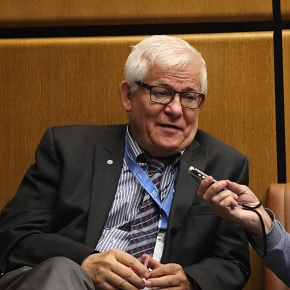 |
||
|
Atommash has successfully performed the hydraulic tests of the reactor pressure vessel for the first power unit of the Akkuyu NPP under construction in Turkey AEM-technology, PUBLISHED 13.07.2020 The Volgodonsk Branch of JSC "AEM-technology" "Atommash" (part of the Rosatom Engineering Division - Atomenergomash) successfully completed the hydraulic tests of the first reactor for the first power unit of the "Akkuyu" NPP under construction in Turkey. To carry out the final stage in the manufacturing process of the reactor pressure vessel, a special underground test bench is used - a caisson. A support ring was placed in it, on which, using a crane with a lifting capacity of 600 tons, the reactor pressure vessel was installed in the design position and closed with a process cover. Hydraulic tests were carried out in accordance with a special technology, during which a maximum pressure (24.5 MPa) was generated in the reactor pressure vessel 1.4 times higher than the operating pressure. The reactor is a vertical cylindrical 334 tons-weight vessel with an elliptical bottom, inside of which the reactor core and internalsare arranged. From above, the reactor is tightly sealed by a cover with the drives of mechanisms and control elements designed to regulate and protect the reactors and nozzles for outputting the cables of the sensors for on-site monitoring installed on it. According to the Director of the Volgodonsk branch of JSC "AEM-technology" Rovshan Abbasov, preparation for hydrotests of the reactor pressure vessel was carried out in difficult quarantine conditions. Despite this, Atommash specialists ensured accurate and high-quality execution of all necessary operations. "Hydraulic tests have confirmed the strength of the base metal and welded joints of the reactor pressure vessel, the readiness of the item for operation at the power plant for a specified life of 60 years," he emphasized. The "Akkuyu" NPP is the first nuclear power plant under construction in the Republic of Turkey. The Akkuyu NPP project includes four power units with Russian design VVER reactors of generation 3+. The capacity of each nuclear power unit will be 1,200 MW. To date, the project is fully funded by the Russian side. The construction of the "Akkuyu NPP" is the first project in the world nuclear industry, implemented according to the Build-Own-Operate (BOO) model. The Joint-Stock Company "AEM-technology", founded in 2007 in the structure of JSC "Atomenergomash", an engineering division of the State Atomic Energy Corporation "Rosatom", is currently one of the leading Russian companies in the field of power engineering, a member of the Russian Engineering Union. The company's structure includes an engineering center staffed by experienced designers and process-engineers, as well as two production sites: the Branch of JSC "AEM-technology" "Petrozavodskmash" in Petrozavodsk and the Branch of JSC "AEM-technology" "Atommash" in Volgodonsk. Topics: Nuclear industry, Turkey Other news: The complete MOX-core is planned in 2022. WANO, IAEA, EPRI collaborate to help new nuclear power units to start up safely and on time The white paper is available here (bottom left section to download). 440 nuclear units are operating in the world Another 54 units are under construction. |
Hero of the day 
Managing Nuclear Knowledge - A Forward Looking Story Knowledge management came into existence as a new stream in the distinct area of information management at the beginning of the 90-ies. Many believe that the term "knowledge management" has been invented by the consulting community. INTERVIEW
William D. Magwood, IV OPINION
Alexey Lankevich |

